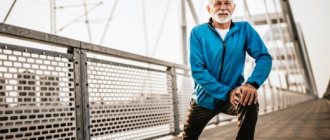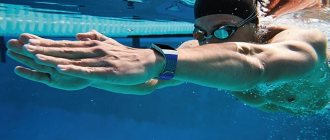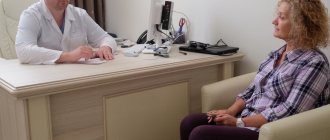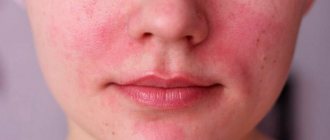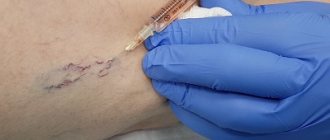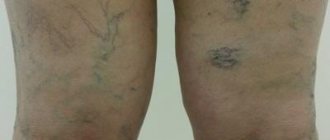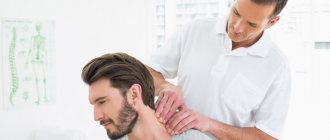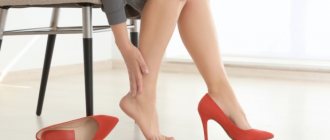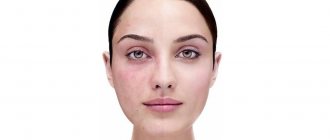The price to pay for walking upright: how varicose veins work
Varicose veins are the expansion of varicose veins.
The veins in the legs are needed for the outflow of blood: blood flows through the arteries to the leg, through the veins - from the legs to the heart. My legs are always down, the blood has to flow against the force of gravity - up, it’s hard. The legs have the most unfavorable blood flow in the entire body.
“Genetically, a person is not yet fully adapted to walking upright, so there are weak points in the body,” explains Dmitry Averyanov. Every third woman and every fifth man initially has weak spots in the veins of the legs. During life, the vein in these places expands due to stress: for some from pregnancy, for others from lifting heavy objects or being overweight. There can be many reasons, but the root cause is weakness of the venous wall.
Veins have valves that facilitate the upward movement of blood. When the vein dilates, these valves stop closing and the vein cannot hold blood.
The blood partially begins to flow back down. “The leg is always like an unfinished bottle - there is always residual venous blood in it,” notes Dmitry Averyanov. This causes the unpleasant symptoms characteristic of varicose veins: heaviness in the legs, swelling, fatigue, bulging veins.
At the same time, there are a lot of veins in the legs: deep, muscular, subcutaneous, but varicose veins only affect the subcutaneous ones.
Spider veins/spider veins: what is it, is it dangerous and can creams help?
Capillary meshwork (reticular varicose veins) and stars (telangiectasia) are the expansion of small veins no more than 3 mm in diameter. This type of varicose veins can occur as a concomitant of varicose veins, or independently. Such “stars” can appear not only on the legs, but also on the face, chest and other places. The causes of reticular varicose veins are unknown. Unlike varicose veins, this is not a disease. Reticular varicose veins are only an aesthetic problem, like wrinkles and gray hair - there are no negative consequences for the body.
If “varicose veins” are a consequence of varicose veins, then to prevent its occurrence it is necessary to treat varicose veins. If the “stars” arose on their own, then treatment or prevention is not required. However, if a person is aesthetically unsatisfied with the presence of a vascular pattern, it can be removed.
Bath and massage: with a “mesh” it’s possible, but with varicose veins it’s not worth it
It is believed that massage and visiting the bathhouse/sauna are prohibited for varicose veins. If we are not talking about varicose veins, but specifically reticular varicose veins, then there are no such restrictions - you can go to a massage or a sauna. However, for some skin types, massage can actually trigger the appearance of additional spider veins (but not in all people). If spider veins are present not only on the legs, but also under the breasts, on the buttocks - that is, in places of pressure and trauma - forceful massage should not be used, because it can provoke the appearance of additional "stars". But not everyone has this reaction.
Massage in the case of varicose veins can cause thrombosis (formation of blood clots in a vein - thrombi) and thrombophlebitis (inflammation of the walls of the veins), because the venous outflow is impaired and the wall changes greatly during expansion. Therefore, if a diagnosis of varicose veins is established, then a power massage on the leg where there are varicose veins is contraindicated - but a weak lymphatic drainage massage is acceptable.
Prohibitions for varicose veins, which are important to know about
When treating any disease, we are faced with the need to take certain medications, maintain a proper diet or diet, and also receive recommendations from the doctor on what can and cannot be done. Today we’ll talk about the prohibitions for varicose veins of the lower extremities, which are important for everyone to know about.
1). The first prohibition concerns bad habits (smoking and alcohol).
It’s not for nothing that a phlebologist asks about this during a consultation. Varicose veins are still a completely unknown disease, but it is known for sure that disruption of the venous system occurs as a result of an incorrect lifestyle. Smoking leads to the destruction of the walls of venous and arterial vessels, making them fragile and brittle. And cholesterol plaques are deposited on the walls of the arteries, which gradually lead to complete occlusion (closure) and disruption of blood flow in the extremities leading to ischemia and tissue death (gangrene). Alcohol and smoking thicken the blood, which causes blood clots to form. Alcohol also retains fluid in the tissues, which leads to the formation of edema and overload of the venous system.
2). Overweight.
Many diseases are aggravated by obesity and varicose veins are one of them. Excess weight makes a person less mobile (you want to lie down and relax more) and this is not accidental. First of all, there is a colossal load on the legs. The joints suffer; they fail most quickly, making a person even more hypodynamic. As a result of limited movement in the legs, the functioning of the venous pump in the legs is disrupted. The blood in the veins begins to stagnate - this all leads to varicose veins. What to do if you are already obese? There are four rules:
- Drink about 1.5 - 2.0 liters of clean filtered water to thin the blood.
- Fractional meals (eat in small portions about 5 - 6 times a day).
- Don't eat at night.
- Eating foods enriched with fiber. They normalize intestinal function, improve metabolism and help fight excess weight (buckwheat, pearl barley, bran, lentils, beans, pumpkin, cabbage, apples, apricots, etc.).
3). Use of hormonal contraception.
Hormonal contraceptives for varicose veins expose the female body to significant risk. The increased content of female sex hormones in the blood leads to increased pressure on the blood vessels, leading to their dilation. Also, under their influence, the blood becomes thick, which can lead to the formation of blood clots.
4). Baths, saunas, solariums (exposure to high temperatures).
Under the influence of high temperatures, there is an increase in blood flow to organs and tissues, increased sweating, all this is necessary to cool our body and protect it from overheating. Accordingly, as the flow of blood increases, its outflow also increases. Which leads to excessive strain on the veins. If the latter are varicose and the venous outflow through them is already impaired, this leads to their even greater expansion and even greater stagnation of blood. Increased sweating dehydrates the body and leads to blood thickening, which in turn leads to thrombosis. This is also why varicose veins most often worsen in the summer.
5). Sedentary lifestyle.
Technological progress and computerization provide people with comfort in everyday life. You no longer need to go to the store - you can buy everything online without leaving your home. A century of physical inactivity leads to a sedentary lifestyle. With varicose veins, the blood in the diseased veins cannot rise on its own due to non-functioning valves. Such veins have difficulty pumping blood to the heart, and in advanced stages they generally look like bags filled with blood that is not flowing anywhere. In order to force the blood to rise through such veins, you need to force the muscles to work. It’s not for nothing that they say that our muscles on the lower leg (muscle pump or muscle pump) are a second heart. The muscles on the lower leg, contracting, massage the adjacent veins, squeezing them and forcing the blood to move upward through the vessels, causing the venous valves to work better. This is why walking is beneficial for varicose veins in the legs.
6). Self-medication.
As the song says: “If you don’t have an aunt, then you won’t lose her.” But if you have varicose veins, the disease itself will certainly not go away. Tablets and ointments only reduce the symptoms of the disease, facilitate the flow of blood through the veins, relieve inflammation, and relieve swelling. That is, they improve the quality of life with varicose veins, but do not affect the cause of the disease. There are no magic cures for varicose veins. Self-medication is not only harmful, but also dangerous. Mechanical damage to valves and varicose veins is unfortunately not a reversible process that requires surgical intervention. If you have signs of varicose veins, you should consult a doctor. Therefore, do not hesitate to visit a phlebologist. Just like with caries on a tooth, no matter how much you apply garlic to your wrist for a toothache, we understand that you will still have to go to the dentist, drill the tooth and put a filling.
7). Leeches and varicose veins.
Varicose veins cannot be cured with leeches. Hirudin released in the saliva of these blood-sucking animals actually reduces blood clotting, but this has no effect on varicose veins. This treatment does not strengthen the venous walls and does not normalize the condition of the blood vessels. I often use leeches repeatedly, which leads to infection with various infections (cases of infection with hepatitis C and B are not uncommon). You should also not place leeches on swollen varicose veins - this can lead to rupture of the vessel and bleeding.
8). Massage for varicose veins.
It all depends on the massage technique used. For varicose veins, only a soft, stroking massage aimed at draining blood and lymph from the extremities is possible. Powerful massage techniques for varicose veins are harmful (honey, cupping, vacuum, anti-cellulite). The use of pneumocompression is useful - this is a special type of physiotherapeutic treatment in which, with the help of a pump and inflatable boots, it is possible to improve the outflow of blood and lymph through the vessels.
9). Exercising with varicose veins.
It is clear that sports activities and varicose veins are two opposites. All loads in a vertical position must be excluded. Among those prohibited: deadlifting (lifting weights in a vertical position), running (sprinting, marathon), squats, lunges, jumping (especially on a skipping rope), exercises with a platform (step aerobics). All of the above increases the load on varicose veins and can lead to thrombosis. With varicose veins, fitness is still necessary to increase the tone of the veins and strengthen their walls. If you have varicose veins, then fitness classes should be carried out with an experienced instructor and using compression stockings. The following exercises are allowed: flattening, lying leg raises, bicycle exercise, swinging legs back in a knee-elbow position, lying leg press, calm walking on a treadmill.
A diagnosis of varicose veins does not mean the end of a healthy life. Varicose veins are a chronic disease that can be treated surgically. Open, traumatic operations to remove veins are a thing of the past. Today, varicose veins are treated all over the world using minimally invasive techniques and laser technology. If surgery is recommended for you, it should not be put off for too long. Over time, the condition of the veins deteriorates, complications appear in the form of inflammation of the vein walls and the formation of blood clots (varicothrombophlebitis), severe edema, night cramps, as well as deterioration in the nutrition of the skin of the legs, leading to the formation of chronic trophic ulcers. That is why, if a phlebologist recommended that you have surgery now, you should not postpone it until later.
Be healthy!
Make an appointment with a phlebologist surgeon
Surgeon-phlebologist - Andrey Aleksandrovich Nisin
You can make an appointment by calling (391) 205−00−48 or through your personal account
You can play sports if you have varicose veins. And even necessary
80% of cases of detected varicose veins are the second stage of the disease, when not only the veins bulge out, but there are also symptoms: swelling, heaviness in the legs, legs get tired and hurt. These symptoms mainly appear when a person sits or stands in one position for a long time. When playing sports, there are usually no such sensations. On the contrary, running, squats, even strength exercises on the legs are good for the veins - they all improve venous outflow. Sports games - volleyball, football - also relieve varicose veins in the legs.
The only sports activity that worsens venous outflow is lifting weights, and more specifically, a barbell heavier than a person’s own weight. Injuries can also be dangerous (impacts to the leg can cause thrombosis) and some static postures (for example, static positions in a squat and half-squat). And everything related to movement is good for veins, even regular walking. Exercises for the mobility of the foot, leg, and calf muscles are especially useful - there are veins that are well involved in the outflow. Standing and sitting are bad for veins, but walking and lying are good.
Varicose veins are also common among athletes. But if a person is active, then he tolerates the disease more easily. Athletes with varicose veins seek help later than others because their symptoms are partially compensated by training. However, this does not mean that athletes do not need to treat existing varicose veins.
Fitness and varicose veins in Moscow. Modern exercises for varicose veins
Here is a fairly simple example of simple physical exercises available to almost any resident of Moscow:
- Raise your legs to the “birch” position and shake them relaxed.
- Lying on your back, bend your legs and rotate them at the knee joints in one direction, then in the other direction.
- Lying on your back, spin your legs like a bicycle.
Exercises for varicose veins
Varicose veins are not an obstacle to physical activity, although physical activity should be chosen carefully. Lifting weights, jumping, and running are contraindicated; static exercises performed while standing should be limited. Strength training is performed only in a lying position, and the load on the abdominal press must be strictly dosed. When visiting a fitness center, you should warn the trainer about the presence of symptoms of varicose veins. The most suitable types of physical activity for varicose veins are swimming and water aerobics, which effectively relieve stress from the legs.
Water aerobics for varicose veins
Exercises that activate diaphragmatic breathing, especially yoga, restore blood circulation well. Stretching and Pilates are very useful, especially in a lying position. These directions are available to residents of Moscow and the Moscow region with professional instructors.
Yoga for varicose veins
What cannot cure varicose veins: pills, creams and stockings
To alleviate the negative symptoms of varicose veins, compression hosiery is used: these are socks, stockings or tights that create pressure on the legs to improve blood flow. Knitwear is used more often for static positions (if you need to sit in an office, stand at a counter or behind a pulpit), and during sports, blood flow improves due to movement, so you can exercise without compression garments.
Most often, advertisements offer creams as a treatment for varicose veins. They won't help. The cause of varicose veins is not clear, and there is not a single drug with a proven effect - preventive or therapeutic. Therefore, none of the creams that are sold “for varicose veins” have proven effectiveness.
Venotonics/phlebotonics tablets will also not help “remove” varicose veins and will not make the veins that bulge out due to varicose veins disappear. All phlebotonics, when used for varicose veins, are exclusively symptomatic drugs; they alleviate or remove symptoms, but do not improve or prevent anything. Phlebotonics are also indicated if there is no varicose veins, but there is heaviness and swelling in the legs. If you have varicose veins, but you don’t want to have surgery, phlebotonics are also indicated to relieve symptoms.
Sports for vein pathologies in the postoperative period
During the rehabilitation period after vascular surgery, it is extremely important to give your legs moderate physical activity. It promotes the speedy restoration of normal blood flow and prevents the formation of blood clots. However, it must be taken into account that resuming sports with varicose veins after surgery must be done carefully and gradually. The best option for physical activity in this case is walking and performing physical therapy exercises recommended by your doctor.
Sports for varicose veins in the postoperative period
The only treatment is surgery: is it possible to do without incisions?
Varicose veins are a disease that can only be treated radically - surgically. There are many types of operations: using a laser (sealing veins), sclerotherapy (a special drug is injected into the vein, as a result it “sticks together”), phlebectomy (classic operation - removal of veins from incisions), miniphlebectomy (removal without incisions, through punctures - minimally invasive method).
Traditionally, these operations are performed under local anesthesia. As a rule, they are so minimally invasive that you can get up and walk immediately after returning from the operating room. This is done to prevent a rare but dangerous complication - deep vein thrombosis. If the patient wishes or is afraid, it is permissible to use general anesthesia for a short period of time. On average, the operation lasts half an hour. After the intervention, there are no stitches left (except for a variant of the classical operation, which is now practically not used) - only temporary bruises.
Modern treatment methods allow you to start training at any intensity already 3-4 days after surgery. And already a month after the operation, you can again engage in those sports that are not recommended for varicose veins - for example, lifting weights.
There is an opinion that after surgery and sealing of some veins, over time the neighboring ones will inevitably begin to expand. However, the average relapse rate is 15%. That is, only 15% of those operated on will experience a relapse during the rest of their lives. Therefore, all patients with varicose veins, even after surgery, are recommended to visit a phlebologist once a year.
Compression garments for sports
Compression stockings, knee socks or tights are a must-have item that you should always use during training, no matter what sport you play. Compression underwear provides support for blood vessels and soft tissues, allows you to increase the effectiveness and duration of training, and also provides high-quality prevention of varicose veins, thrombosis and many other diseases that often appear when the proper functioning of the blood is disrupted. You can buy compression hosiery on the website of the Orthosalon online store or in the Medtechnika Orthosalon network in your city.
